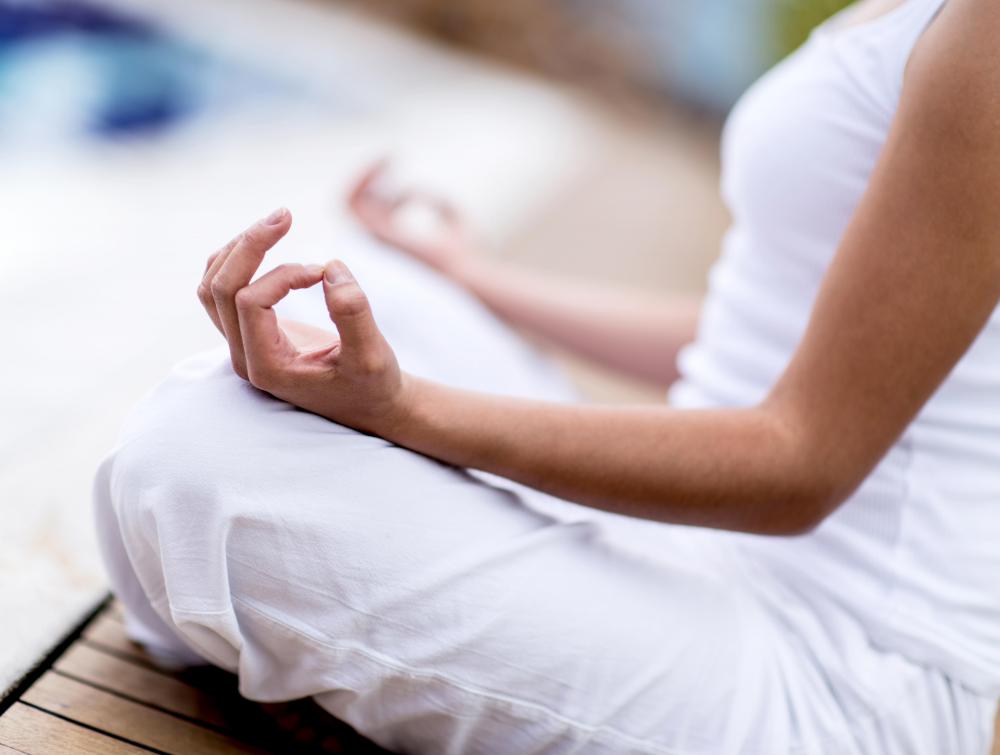At WiseGEEK, we're committed to delivering accurate, trustworthy information. Our expert-authored content is rigorously fact-checked and sourced from credible authorities. Discover how we uphold the highest standards in providing you with reliable knowledge.
What Are the Different Methods of Meditation for Children?
Depending on the age of the child, there are several different types of meditation for children. Children younger than eight years old may benefit from watching their parents meditate or by holding simple yoga poses geared to bring stillness to their bodies. An older child can participate in other types of meditation for children, such as mindfulness, transcendental, or heart rhythm meditation, and meditation using visualization. Although many types of religious meditation for children originated from Hindu or Buddhist principles, there are certain types that use Judaism, Christianity or other religions as their base.
Meditation for children who are only two or three years old may seem daunting, but it is possible. In most cases, these children will be best able to meditate if they have seen their parents meditate. These young children will meditate by example, in some cases simply following the appearance of meditation by lying on their backs and taking deep breaths.

Children who are about four or five years old may be able to enter into some meditative poses, such as the corpse pose, or savasana. If they are able to follow simple directions, they will be able to lie on their backs and find stillness and relaxation. In some cases, the parents may help them bring awareness to their bodies by directing them to focus on one part of the body at a time. For example, after finding stillness, they may be asked to slowly wriggle their toes.

Children who are a little older may be able to bring all five senses into their meditation practices. For example, they could lie on their backs and find stillness, then be asked to focus on the world around them, all while keeping their eyes closed. For example, they might be asked to silently reflect on what they smell or hear. They may also be asked to reflect on how their bodies feel while they are meditating.

When children reach the age of eight, they typically are able to participate in deeper types of meditation. For example, mindfulness meditation for children is possible. Through this type of meditation, the child will breathe slowly and deeply. He will fully fill his lungs and then fully empty them. Then, in some types of meditation, the child will alternate his breath through each nostril, inhaling on one side of the nose and exhaling out the alternate side of the nose.
Transcendental meditation for children is also possible. This type of meditation can use words or phrases from any religion or belief system. Through transcendental meditation, the child will repeat a word or phrase, silently or quietly. By focusing on a word or phrase, the child will stop distracting thoughts. He will become relaxed and, eventually, he may have a greater awareness of his surroundings.
Heart rhythm meditation for children may also be used. With this type of meditation, the child will find his heartbeat with the palm of his hand. He will then slowly inhale, while counting his heartbeats. He will then exhale, also counting his heartbeats. It brings focus to his body, works to relax his mind, and voids it of any thoughts other than counting the beats of his heart.
A final type of meditation for children is called visualization. Through visualization, the child will focus on creating an object, pattern, or scene in his mind. For example, the child could attempt to visualize being wrapped up in warm blankets. Once the visualization is formed, the child can then meditate on how it feels. This type of meditation also works to relax the child and frees him from distracting thoughts.
AS FEATURED ON:
AS FEATURED ON:













Discussion Comments
@pastanaga - I can remember my teacher doing some guided meditation with me when I was in school and I really enjoyed it. I don't remember thinking it was meditation at the time, though. I thought it was just another part of health classes.
I think for young children it would be great to have short bouts of meditation incorporated into mat time, when they are all seated together in class.
@browncoat - Basically mindfulness allows you to stop thinking about problems because you're too busy thinking about what is around you and living in the moment. It's surprisingly difficult to maintain if you aren't used to it, but there are some really good applications online, intended to help develop mindfulness meditation and these might be helpful with children.
I think it's one of the better techniques to use with young people because it allows their mind to be somewhat active so their attention doesn't waver. Guided meditation is good for this as well and it's probably the way I would introduce meditation in general to children.
Mindfulness is a very excellent technique for children to learn, particularly if they suffer from anxiety or have had trauma in their lives.
My counselor explained it as a way of allowing your mind to rest from a constant state of worry. Basically you take an activity like walking, or showering or eating, which involves all the senses and completely lose yourself in identifying and paying attention to sensory input from that activity. So, for example, on a walk you will want to be listening to every sound you can hear, the feel of the wind and the ground under your feet, the smell of the earth, and the sights you can see. The sensations don't all have to be pleasant, although that can help you pay attention to them.
I will even do this with my headphones on, except I pay close attention to all the different instruments rather than just letting them all blend together.
Post your comments